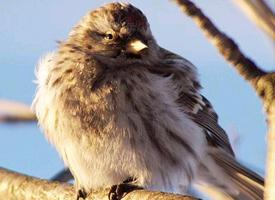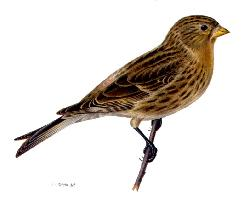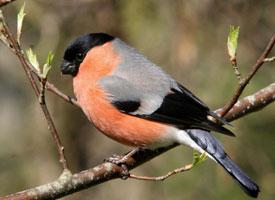
Description de l'animal
The Arctic Redpoll (Acanthis hornemanni), also known as the Hoary Redpoll, is a small passerine bird in the finch family. This species, particularly fascinating for birdwatchers and ornithologists, exhibits remarkable adaptations that allow it to thrive in the extreme cold environments of the Arctic and sub-Arctic regions.Physical Description:
The Arctic Redpoll is a small bird, measuring about 12 to 14 centimeters in length, with a wingspan of approximately 20 to 22 centimeters. It weighs between 12 to 16 grams, making it a lightweight bird adept at navigating through harsh weather conditions. One of its most distinctive features is its plumage, which is primarily a soft, pale color that ranges from whitish to light gray. This serves as excellent camouflage against the snowy and icy landscapes it inhabits.
The bird is named for the small patch of red found on the crown of its head, which is more pronounced in males. The cheeks are usually a lighter color, providing a striking contrast against the darker areas around the eyes. Its back is streaked with black, and the underparts are predominantly white, sometimes with light streaking. The bill is small and conical, perfectly adapted for its diet of seeds and small invertebrates. During the winter, the bird's plumage fluffs up, providing additional insulation against the cold.
Habitat and Distribution:
Arctic Redpolls are native to the circumpolar regions, including parts of Canada, Greenland, northern Europe, and Asia. They are highly adapted to life in cold climates and can be found in tundra landscapes, where trees are scarce, and the ground is covered with low-lying shrubs and grasses. During the winter months, some populations migrate southward but still remain in relatively cold environments.
Behavior and Diet:
These birds are highly social, often found in flocks that can include hundreds of individuals. They are agile flyers, capable of making long migrations despite their small size. The diet of the Arctic Redpoll mainly consists of seeds from a variety of Arctic plants, but they also consume insects during the summer months when such food sources are more abundant. Their ability to store seeds in their crop, a pouch in their esophagus, allows them to feed efficiently during the short Arctic summer and survive the long, harsh winter.
Breeding:
The breeding season for Arctic Redpolls begins in late spring or early summer, when the snow begins to melt. They nest in sheltered locations, often on the ground or low in shrubs, using grasses and feathers to construct their nests. The female lays a clutch of 4 to 6 eggs, which she incubates for about 10 to 14 days. Both parents participate in feeding the chicks, which fledge approximately 2 weeks after hatching.
Conservation Status:
Currently, the Arctic Redpoll is not considered to be at risk. It has a large range and a stable population size. However, like many Arctic species, it could face future threats from climate change, which has the potential to alter its habitat and food sources.
In summary, the Arctic Redpoll is a small, resilient bird that has mastered the art of survival in some of the planet's most unforgiving climates. Its unique adaptations, social behavior, and striking appearance make it a fascinating subject of study and an emblem of the Arctic's natural beauty.
Animaux similaires
Nouvelles photos d'animaux
Top 10 des animaux
- Dolphin gull (Leucophaeus scoresbii)
- Japanese macaque (Macaca fuscata)
- Greek tortoise (Testudo graeca)
- Stone loach (Barbatula barbatula)
- Galápagos tortoise (Geochelone nigra complex)
- Russian tortoise (Testudo horsfieldii)
- Diana monkey (Cercopithecus diana)
- Moustached guenon (Cercopithecus cephus)
- Common flying dragon (Draco volans)
- Galápagos penguin (Spheniscus mendiculus)


